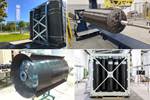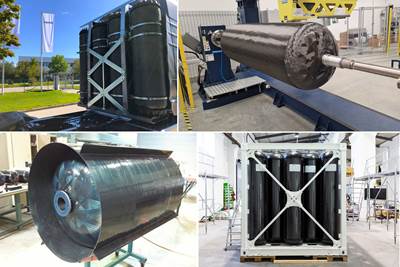Hexagon Agility CNG/RNG tanks integrated into Brudeli for ZEV trucks in North America
Brudeli’s patented plug-in Powerhybrid technology will use Hexagon Agility CNG/RNG fuel system with Type 4 tanks, enabling Class 7 and 8 trucks to meet ACT and ACF regulations.
Hexagon Agility (Costa Mesa, Calif., U.S.), a business of Hexagon Composites (Ålesund, Norway), and the Norwegian electric transmission technology company, Brudeli Green Mobility (Hokksund) have announced a collaboration that aims to disrupt the Class 7 and 8 North American truck market. Hexagon Agility’s compressed natural gas and renewable natural gas (CNG/RNG) systems will be integrated with Brudeli's patented plug-in Powerhybrid technology, offering fleets the capability to maintain diesel-like duty cycles and realize significant fuel cost savings, while achieving decarbonization goals and complying with stringent emissions regulations. The companies plan to introduce the first pilot trucks with this technology in 2026, with serial production slated for 2028.
This technology pairing is reported to enable fleets to make meaningful progress toward ESG goals when fueled with RNG, which is widely available across the nation. In 2023, approximately 79% of all natural gas consumed for transportation in the U.S. came from renewable sources, not fossil fuels.
In California, where RNG accounts for 97% of on-road fuel for natural gas vehicles, the energy-weighted carbon intensity value was around -108 grams of CO2 equivalent/megajoule in 2023, enabling fleets to go beyond carbon neutrality, and actually contribute to reducing global warming potential in the atmosphere.
Source | Hexagon Agility video
Hexagon Agility provides Type 4 composite natural gas cylinders made using carbon fiber composites and CNG/RNG storage and distribution systems based on this technology, as well as CNG/RNG fuel systems for zero-emission powertrains. These products transport gaseous clean fuels and enable vehicles to reduce emissions while saving operating costs.
On the other hand, the Brudeli Powerhybrid enables long-haul trucks to operate using up to 80% electric energy via a dual electric motor system. This setup enables the powertrain to switch between serial and parallel hybrid modes, so the truck can operate in the most efficient mode as vehicle speed, load, driving patterns and battery charge level vary. This maximizes fuel economy and performance and provides flexibility for fleets to operate with clean energy options that are readily available.
The truck can be refueled with RNG on-site or at one of more than 800 public natural gas fueling stations across the U.S. when on longer trips. To enable fleets to operate in zero-emission-only mode in sensitive areas, the plug-in battery system can be charged overnight with a Level 2 charger, which is typically less expensive to install than DC fast chargers and can cost less per kilowatt-hour consumed, according to the company. The batteries will also charge via regenerative braking energy.
“There is growing awareness of the need to cut emissions from medium- and heavy-duty trucks, which make up more than 20% of overall CO2 emissions in the U.S. transport sector,” says Lasse Bjørkhaug, CEO at Brudeli. “Our partnership with Hexagon enables fleets in hard-to-electrify market segments to achieve zero-emission operation in sensitive areas, while eliminating range anxiety for longer trips with RNG. Additionally, fleet operators will benefit from trucks that offer superior electric-like performance without the same payload restrictions.”
Brudeli reports that its Powerhybrid technology, offering 75-miles of all-electric range, is targeted to be the first near zero emission vehicle-compliant (NZEV-compliant) technology commercially available in the U.S. market. Once NZEV certified, the Class 7 and 8 trucks with Brudeli’s technology would comply with the Advanced Clean Truck (ACT) rule, which has been adopted by California and 10 additional states with more on the way.
Fleet operators would also be compliant with California’s Advanced Clean Fleets (ACF) rule for the operating life of any vehicle equipped with this solution that is purchased before 2036.
“The Brudeli Powerhybrid enables fleet owners to retain the power, performance, and fuel cost-savings offered by natural gas engines, while simultaneously harnessing the efficiencies of electric,” says Eric Bippus, executive vice president of sales and systems development at Hexagon Agility. “We believe hybrid could play a role in commercial trucking in the future, and we are excited to take an active role bringing that to the market.”
Related Content
The lessons behind OceanGate
Carbon fiber composites faced much criticism in the wake of the OceanGate submersible accident. CW’s publisher Jeff Sloan explains that it’s not that simple.
Read MoreCombining multifunctional thermoplastic composites, additive manufacturing for next-gen airframe structures
The DOMMINIO project combines AFP with 3D printed gyroid cores, embedded SHM sensors and smart materials for induction-driven disassembly of parts at end of life.
Read MoreCryo-compressed hydrogen, the best solution for storage and refueling stations?
Cryomotive’s CRYOGAS solution claims the highest storage density, lowest refueling cost and widest operating range without H2 losses while using one-fifth the carbon fiber required in compressed gas tanks.
Read MorePlant tour: Albany Engineered Composites, Rochester, N.H., U.S.
Efficient, high-quality, well-controlled composites manufacturing at volume is the mantra for this 3D weaving specialist.
Read MoreRead Next
Composites end markets: Pressure vessels (2024)
The market for pressure vessels used to store zero-emission fuels is rapidly growing, with ongoing developments and commercialization of Type 3, 4 and 5 tanks.
Read MoreHexagon Purus to supply hydrogen storage to Toyota Motors North America
Hydrogen storage and high-voltage battery system to support Class 8 heavy-duty fuel cell powertrains developed by Toyota.
Read MoreDeveloping bonded composite repair for ships, offshore units
Bureau Veritas and industry partners issue guidelines and pave the way for certification via StrengthBond Offshore project.
Read More

























